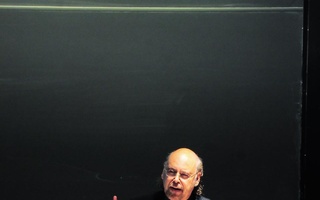Randall White, an archaeologist and professor of anthropology at New York University, really digs his job.
“What other jobs could you have that people pay you to do this kind of stuff?” White said to a crowd gathered Tuesday at Harvard’s Peabody Museum of Archaeology and Ethnology, when asked about the origins of his passion for archaeology.
Delivering this year’s Hallam L. Movius, Jr. Lecture entitled “Modern Humans’ Earliest Artwork and Music: New European Discoveries”, White shed light upon the “treasure trove” of early Aurignacian artwork excavated from French, German, and Romanian archeological sites. The Aurignacian artwork of Upper Paleolithic Europe is the earliest known art made by modern humans.
“In my whole career, I’ve never had the sensation I had when I turned over the block from Blanchard and saw an image that no one had seen for 37,000 years,” White said, referring to an Aurignacian excavation site in France. “How can you not like this job? Where else can you get that?”
White spent much of the lecture describing discoveries of “personal adornment,” early ornaments like pierced shells and teeth from a variety of animals, such as bears and horses. White lamented that some ornaments were found damaged and out of their original place because old excavation techniques often carelessly left them in the discarded dirt pile.
“I’ve had the very disagreeable experience of passing many, many field seasons walking on hundreds of stone artifacts left in the backdirt by these early excavators because they made very severe choices about what they kept,” White said. “For an archaeologist who’s really interested in context, it’s depressing to see what was destroyed.”
Concluding his lecture, White played an audio clip of experimental replicas of Aurignacian flutes.
“We don’t know what the music was like, but we certainly know what the sound qualities of the instruments were,” White said. “It adds a whole new dimension to our thinking of these 40,000 year-old Europeans.”
Jeffrey Quilter, director of the Peabody Museum, praised White for contributing an “outstanding” lecture to the Movius Lecture series, which he described as “one of the high points of our public programs.”
“It’s a special treat to have Dr. Movius’ son here,” Quilter said. “He has been very supportive of the museum in the past, and it’s great that he can share it. He was actually at some of these sites as a youth, so it adds an extra special dimension to the event.”
Geoffrey H. Movius ‘62, Movius’s son, said he enjoyed the talk, and said the lecture series in general serves as “an annual reminder” of his father’s life work.
“I thought it was a fascinating talk,” Movius said. “This is the largest crowd I’ve seen at one of these. I think my father, after whom this lecture is named, would have been fascinated with what Professor White had to say.”
Read more in University News
Law School Professor Cass R. Sunstein Wins Holberg PrizeRecommended Articles
-
Dinsmoor Lectures on Athens' DevelopmentWilliam Bell Dinsmoor '06, professor of Archaeology at Columbia and foremost Greek archeologist in America, will give an illustrated lecture
-
University Calendar.Sunday, April 10. APPLETON CHAPEL, 7.30 P. M. Dr. Felix Adler, of New York, N. Y. Rev. Francis G. Peabody,
-
University CalendarTuesday, March 28. **MORNING PRAYERS. Rev. Albert Parker Fitch '00, D.D., President of the Andover Theological Seminary. Appleton Chapel, 8.45
-
Warner to Lecture"The Current Exhibition of Japanese Decorative Art" is the subject of a lecture to be given by Langdon Warner '03,
-
 Lecture Series Seeks to Strengthen Harvard's Ties to Mexico
Lecture Series Seeks to Strengthen Harvard's Ties to Mexico













